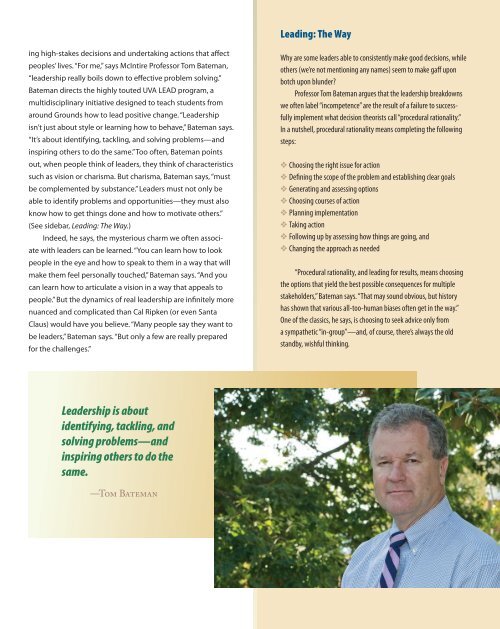CommerceUVA Fall 2007 (Investors' Report) - McIntire School of ...
CommerceUVA Fall 2007 (Investors' Report) - McIntire School of ...
CommerceUVA Fall 2007 (Investors' Report) - McIntire School of ...
You also want an ePaper? Increase the reach of your titles
YUMPU automatically turns print PDFs into web optimized ePapers that Google loves.
ing high-stakes decisions and undertaking actions that affect<br />
peoples’ lives. “For me,” says mcintire pr<strong>of</strong>essor tom Bateman,<br />
“leadership really boils down to effective problem solving.”<br />
Bateman directs the highly touted uva lead program, a<br />
multidisciplinary initiative designed to teach students from<br />
around Grounds how to lead positive change. “leadership<br />
isn’t just about style or learning how to behave,” Bateman says.<br />
“it’s about identifying, tackling, and solving problems—and<br />
inspiring others to do the same.” too <strong>of</strong>ten, Bateman points<br />
out, when people think <strong>of</strong> leaders, they think <strong>of</strong> characteristics<br />
such as vision or charisma. But charisma, Bateman says, “must<br />
be complemented by substance.” leaders must not only be<br />
able to identify problems and opportunities—they must also<br />
know how to get things done and how to motivate others.”<br />
(see sidebar, Leading: The Way.)<br />
indeed, he says, the mysterious charm we <strong>of</strong>ten associate<br />
with leaders can be learned. “you can learn how to look<br />
people in the eye and how to speak to them in a way that will<br />
make them feel personally touched,” Bateman says. “and you<br />
can learn how to articulate a vision in a way that appeals to<br />
people.” But the dynamics <strong>of</strong> real leadership are infinitely more<br />
nuanced and complicated than Cal ripken (or even santa<br />
Claus) would have you believe. “many people say they want to<br />
be leaders,” Bateman says. “But only a few are really prepared<br />
for the challenges.”<br />
Leadership is about<br />
identifying, tackling, and<br />
solving problems—and<br />
inspiring others to do the<br />
same.<br />
—Tom Bateman<br />
Leading: The Way<br />
Why are some leaders able to consistently make good decisions, while<br />
others (we’re not mentioning any names) seem to make gaff upon<br />
botch upon blunder?<br />
Pr<strong>of</strong>essor Tom Bateman argues that the leadership breakdowns<br />
we <strong>of</strong>ten label “incompetence” are the result <strong>of</strong> a failure to successfully<br />
implement what decision theorists call “procedural rationality.”<br />
In a nutshell, procedural rationality means completing the following<br />
steps:<br />
❖ Choosing the right issue for action<br />
❖ Defining the scope <strong>of</strong> the problem and establishing clear goals<br />
❖ Generating and assessing options<br />
❖ Choosing courses <strong>of</strong> action<br />
❖ Planning implementation<br />
❖ Taking action<br />
❖ Following up by assessing how things are going, and<br />
❖ Changing the approach as needed<br />
“Procedural rationality, and leading for results, means choosing<br />
the options that yield the best possible consequences for multiple<br />
stakeholders,” Bateman says. “That may sound obvious, but history<br />
has shown that various all-too-human biases <strong>of</strong>ten get in the way.”<br />
One <strong>of</strong> the classics, he says, is choosing to seek advice only from<br />
a sympathetic “in-group”—and, <strong>of</strong> course, there’s always the old<br />
standby, wishful thinking.<br />
<strong>Fall</strong> <strong>2007</strong> • 17





